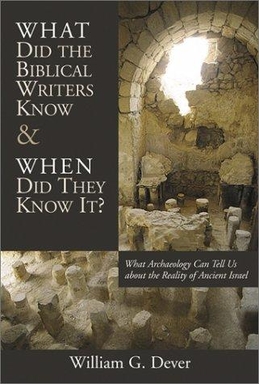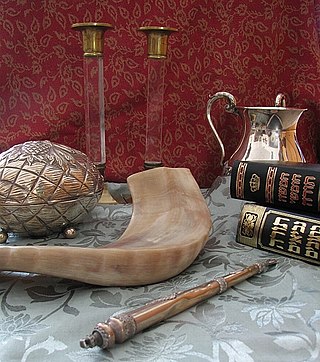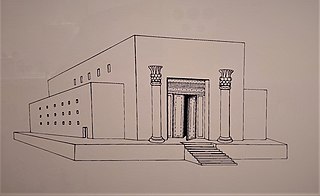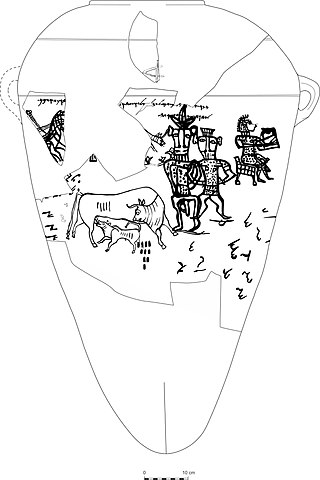Related Research Articles

The history of ancient Israel and Judah begins in the Southern Levant region of Western Asia during the Late Bronze Age and Early Iron Age. The earliest known reference to "Israel" as a people or tribal confederation is in the Merneptah Stele, an inscription from ancient Egypt that dates to about 1208 BCE, but the people group may be older. According to modern archaeology, ancient Israelite culture developed as an outgrowth from the pre-existing Canaanite civilization. Two related Israelite polities known as the Kingdom of Israel (Samaria) and the Kingdom of Judah had emerged in the region by Iron Age II.

The Kingdom of Judah was a Hebrew-speaking kingdom of the Southern Levant during the Iron Age. Centered in the highlands of Judea, the landlocked kingdom's capital was Jerusalem. Jews are named after Judah and are primarily descended from it.

Yahweh was an ancient Levantine deity, and national god of the Israelite kingdoms of Israel and Judah. Though no consensus exists regarding the deity's origins, scholars generally contend that Yahweh emerged as a "divine warrior" associated first with Seir, Edom, Paran and Teman, and later with Canaan. The origins of his worship reach at least to the early Iron Age, and likely to the Late Bronze Age, if not somewhat earlier.

The Israelites were a group of Semitic-speaking tribes in the ancient Near East who, during the Iron Age, inhabited a part of Canaan.
The historicity of the Bible is the question of the Bible's relationship to history—covering not just the Bible's acceptability as history but also the ability to understand the literary forms of biblical narrative. One can extend biblical historicity to the evaluation of whether or not the Christian New Testament is an accurate record of the historical Jesus and of the Apostolic Age. This tends to vary depending upon the opinion of the scholar.

Israel Finkelstein is an Israeli archaeologist, professor emeritus at Tel Aviv University and the head of the School of Archaeology and Maritime Cultures at the University of Haifa. Finkelstein is active in the archaeology of the Levant and is an applicant of archaeological data in reconstructing biblical history. He is also known for applying the exact and life sciences in archaeological and historical reconstruction. Finkelstein is the current excavator of Megiddo, a key site for the study of the Bronze and Iron Ages in the Levant.

Biblical archaeology is an academic school and a subset of Biblical studies and Levantine archaeology. Biblical archaeology studies archaeological sites from the Ancient Near East and especially the Holy Land, from biblical times.

According to the Deuteronomistic history of the Hebrew Bible, a United Monarchy or United Kingdom of Israel existed under the reigns of Saul, David, and Solomon, encompassing the territories of both the later kingdoms of Judah and Israel.
The patriarchal age is the era of the three biblical patriarchs, Abraham, Isaac and Jacob, according to the narratives of Genesis 12–50. It is preceded in the Bible by the primeval history and followed by The Exodus.

An Asherah pole is a sacred tree or pole that stood near Canaanite religious locations to honor the goddess Asherah. The relation of the literary references to an asherah and archaeological finds of Judaean pillar-figurines has engendered a literature of debate.

The Bible Unearthed: Archaeology's New Vision of Ancient Israel and the Origin of Its Sacred Texts, a book by Israel Finkelstein, Professor of Archaeology at Tel Aviv University, and Neil Asher Silberman, an archaeologist, historian and contributing editor to Archaeology Magazine published in 2001 by Simon & Schuster using its imprint The Free Press and reprinted in 2002 using its Touchstone imprint, discusses the archaeology of Israel and its relationship to the origins and content of the Hebrew Bible.
Thomas L. Thompson is an American-born Danish biblical scholar and theologian. He was professor of theology at the University of Copenhagen from 1993 to 2009. He currently lives in Denmark.
Baruch Halpern is the Covenant Foundation Professor of Jewish Studies at the University of Georgia. He was a leader of the archaeological digs at Tel Megiddo 1992–2007, as well as of an archaeological survey in southeastern Cilicia (Turkey). As an undergraduate at Harvard in 1972, he wrote a political analysis of the Bible, which subsequently influenced research into its authorship.

What Did the Biblical Writers Know and When Did They Know It? What Archaeology Can Tell Us about the Reality of Ancient Israel is a 2001 book by biblical scholar and archaeologist William G. Dever detailing his response to the claims of minimalists to the historicity and value of the Hebrew Bible. The book was also conceived as a response to Thomas L. Thompson's minimalist book The Bible in History.
Did God Have a Wife?: Archaeology and Folk Religion in Ancient Israel is a book by Syro-Palestinian archaeologist William G. Dever, Professor Emeritus of Near Eastern Archeology and Anthropology at the University of Arizona. Did God Have a Wife? was intended as a popular work making available to the general public the evidence long known to archaeologists regarding ancient Israelite religion: namely that the Israelite God of antiquity, Yahweh, had a consort, that her name was Asherah, and that she was part of the Canaanite pantheon.

Who Were the Early Israelites and Where Did They Come From? is a book by American biblical scholar and archaeologist William G. Dever.
"The Bible's Buried Secrets" is a Nova program that first aired on PBS, on November 18, 2008. According to the program's official website: "The film presents the latest archaeological scholarship from the Holy Land to explore the beginnings of modern religion and the origins of the Hebrew Bible, also known as the Old Testament. This archaeological detective story tackles some of the biggest questions in biblical studies: Where did the ancient Israelites come from? Who wrote the Bible, when, and why? How did the worship of one God—the foundation of modern Judaism, Christianity, and Islam—emerge?"

The origins of Judaism lie in Bronze Age polytheistic Canaanite religion. Judaism also syncretized elements of other Semitic religions such as Babylonian religion, which is reflected in the early prophetic books of the Hebrew Bible.

Solomon's Temple, also known as the First Temple, was a biblical Temple in Jerusalem believed to have existed between the 10th and 6th centuries BCE. Its description is largely based on narratives in the Hebrew Bible, in which it was commissioned by biblical king Solomon before being destroyed during the Siege of Jerusalem by Nebuchadnezzar II of the Neo-Babylonian Empire in 587 BCE. Although no remains of the temple have ever been found, most modern scholars agree that the First Temple existed on the Temple Mount in Jerusalem by the time of the Babylonian siege, though there is significant debate over the date of its construction and the identity of its builder.

Yahwism is the name given by modern scholars to the religion of ancient Israel and Judah. Yahwism was essentially polytheistic, with a pantheon of gods and goddesses. Heading the pantheon was Yahweh, the national god of the Israelite kingdoms of Israel and Judah, with his consort, the goddess Asherah, and second-tier gods and goddesses such as Baal, Shamash, Yarikh, Mot, and Astarte, each of whom had their own priests and prophets and numbered royalty among their devotees.
References
- ↑ Confronting the Past: Archaeological and William G. Dever, et al., Historical Essays on Ancient Israel in Honor of William G. Dever (Eisenbrauns, 2006) p ix
- ↑ Dever, William (2001). What did the biblical writers know and when did they know it? What archeology can tell us about the reality of ancient Israel. Grand Rapids, Michigan: Wm. B. Eerdmans Publishing Co. p. 16.
- ↑ "CURRICULUM VITAE (Abbreviated Version 2/5/02)". University of Arizona, Department of Near Eastern Studies. Archived from the original on June 27, 2010. Retrieved April 20, 2015.
- ↑ Dever, William G. (2008) Did God Have a Wife? Archaeology and Folk Religion in Ancient Israel(paperback edition). Cambridge: Eerdmans, page 314.
- ↑ Dever, William G. (2008) Did God Have a Wife? Archaeology and Folk Religion in Ancient Israel (paperback edition). Cambridge: Eerdmans, pages 110 - 175
- ↑ Dever, William G. (2008) Did God Have a Wife? Archaeology and Folk Religion in Ancient Israel (paperback edition). Cambridge: Eerdmans, page 90
- ↑ Dever, William G. (2008) Did God Have a Wife? Archaeology and Folk Religion in Ancient Israel (paperback edition). Cambridge: Eerdmans, pages 153-54, 219-21.
- ↑ An example of one of the Asherah figures that Dever discusses as illustrative of his thesis is illustrated here.
- ↑ Stavrakopoulou, Francesca (2010) 'Popular' Religion and 'Official' Religion: Practice, Perception, Portrayal. In Religious Diversity in Ancient Israel and Judah (Stavrakopoulou, Francesca and John Barton (editors)). London: T&T Clark, pages 43-44.
- ↑ E.g., Aren M. Maeir, Oren Ackermann, and Hendrik J. Bruins, The Ecological Consequences of a Siege in Confronting the Past: Archaeological and Historical Essays on Ancient Israel in Honor of William G. Dever, p. 239, Eisenbrauns (January 1, 2006) ISBN 978-1575061177 ("many seminal contributions to the field", "provided important insights"); Suzanne Richards, op. cit., p. 119 ("done more to advance our knowledge of the EB IV period than any other"); Jake R. McCarty and Eugene H. Merrill, Biblotheca Sacra, January–March 2004, vol. 161, no. 1 ("vast and detailed knowledge").
- ↑ Dever, William G. (January 2003). "Contra Davies". The Bible and Interpretation. Retrieved February 12, 2007.
- ↑ Dever, William G. (March–April 2006). "The Western Cultural Tradition Is at Risk". Biblical Archaeology Review. 32 (2): 26 & 76.
- ↑ Dever, William G. "Archaeology". The Anchor Bible Dictionary. p. 358.
- ↑ Dever, William G. (August 24, 2015). "Save Us from Postmodern Malarkey". Biblical Archaeology Review .
- 1 2 Shanks, Hershel (August 24, 2015). "Debate: In This Corner: William Dever and Israel Finkelstein Debate the Early History of Israel". Biblical Archaeology Review .
- 1 2 "Divided Kingdom, United Critics". Biblical Archaeology Review. July 2, 2014. Retrieved July 19, 2021.
- ↑ Dever, William G. (2002). What Did the Biblical Writers Know and When Did They Know It?: What Archaeology Can Tell Us About the Reality of Ancient Israel: What Archeology Can Tell Us about the Reality of Ancient Israel. William B. Eerdmans Publishing Company.
- ↑ Announcement of appointment Archived March 17, 2010, at the Wayback Machine , Lycoming College.
- ↑ Davies, Philip R. (2002). "What Did the Biblical Writers Know and When Did They Know It? What Archaeology Can Tell Us about the Reality of Ancient Israel [review]". Shofar. 21 (1): 158–160. ISSN 0882-8539.
- ↑ Review by Peter James, Palestine Exploration Quarterly, 134, 2 (2002).
- ↑ Kitchen, K. A. (June 9, 2006). On the Reliability of the Old Testament. Wm. B. Eerdmans Publishing. p. 468. ISBN 978-0-8028-0396-2.
- ↑ "Debate: In This Corner: William Dever and Israel Finkelstein Debate the Early History of Israel". The BAS Library. August 24, 2015. Retrieved July 22, 2021.
- ↑ "In Search of King David's Lost Empire". The New Yorker. June 18, 2020. Retrieved July 22, 2021.
- ↑ See the article Asherah#In Israel and Judah.
- 1 2 3 Shanks, Hershel, ed. (April 2007). "Losing Faith: Who Did and Who Didn't - How Scholarship Affects Scholars". Biblical Archaeology Review . Biblical Archaeology Society. 33 (2). Archived from the original on January 26, 2021. Retrieved August 8, 2021.
- 1 2 Dever, William G.: "Archaeology, Ideology, and the Quest for an Ancient or Biblical Israel", NEA 1998, page 46.